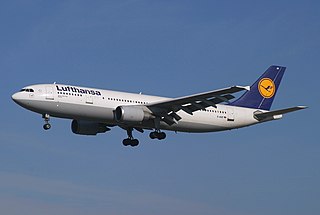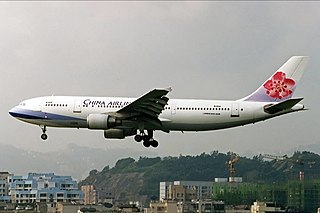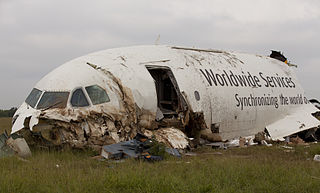
The Airbus A300 is Airbus's first production aircraft and the world's first twin-engine, double-aisle (wide-body) airliner, developed and manufactured by Airbus from 1971 to 2007.
This is a list of aviation-related events from 1997.

Soewondo Air Force Base is currently the military airbase of Medan, North Sumatra, Indonesia. Before 2013, this airport served commercial flights, and was known as Polonia International Airport which was the principal airport that served Medan, North Sumatra, Indonesia, about 2 km from the downtown, and used to serve flights to several Indonesian and Malaysian cities, along with a flight to Singapore and Thailand. Previous international flights had been opened to Hong Kong, Taipei, Amsterdam, Phuket, Chennai, Johor Bahru, Malacca and Ipoh.
PT Merpati Nusantara Airlines, operating as Merpati Nusantara Airlines, was an airline in Indonesia based in Central Jakarta, Jakarta. It operated scheduled domestic services to more than 25 destinations in Indonesia, as well as scheduled international services to East Timor and Malaysia. The word merpati is Indonesian for "dove", and Nusantara is a Javanese word found in the Pararaton meaning "the outer islands", referring to the Indonesian archipelago. The airline was based at Soekarno-Hatta International Airport, Jakarta. It also maintained both a maintenance and simulator facility at Juanda International Airport, Surabaya. The Merpati Training Centre at Surabaya housed Fokker F-27, AVIC MA60 and CN-235 full motion simulators.

China Airlines Flight 676 was a scheduled international passenger flight. On Monday, 16 February 1998, the Airbus A300 jet airliner operating the flight crashed into a road and residential area in Tayuan, Taoyuan County, near Chiang Kai-shek International Airport, Taiwan.

Pilot error generally refers to an accident in which an action or decision made by the pilot was the cause or a contributing factor that led to the accident, but also includes the pilot's failure to make a correct decision or take proper action. Errors are intentional actions that fail to achieve their intended outcomes. The Chicago Convention defines the term "accident" as "an occurrence associated with the operation of an aircraft [...] in which [...] a person is fatally or seriously injured [...] except when the injuries are [...] inflicted by other persons." Hence the definition of "pilot error" does not include deliberate crashing.

China Airlines Flight 140 was a regularly scheduled passenger flight from Chiang Kai-shek International Airport to Nagoya Airport in Nagoya, Japan.

Sam Ratulangi International Airport Manado, is in North Sulawesi, 13 kilometres north-east of Manado. The airport is named after the Minahasan educator and independence hero Sam Ratulangi (1890–1949). It is designated as one of the 11 main entry ports to Indonesia by the Ministry of Tourism and Culture of Indonesia and serves as the main gateway to the Bunaken National Marine Park. It is currently the operating base of Lion Air and Wings Air for the north-eastern part of Indonesia and serves international scheduled flights to several destinations in Asia.

Pakistan International Airlines Flight 268 was an Airbus A300, registration AP-BCP, which crashed while approaching Kathmandu's Tribhuvan International Airport on 28 September 1992. All 167 people on board were killed. Flight 268 is the worst crash of Pakistan International Airlines, and the worst ever to occur in Nepal.

Thai Airways International Flight 311 (TG311/THA311) was a flight from Bangkok, Thailand's Don Mueang International Airport to Kathmandu, Nepal's Tribhuvan International Airport. On Friday, 31 July 1992, an Airbus A310-304 on the route, registration HS-TID, crashed on approach to Kathmandu. At 07:00:26 UTC, the aircraft crashed into the side of a mountain 37 kilometres (23 mi) north of Kathmandu at an altitude of 11,500 ft (3,505 m) and a ground speed of 300 knots, killing all 113 passengers and crew members on board. This was both the first hull loss and the first fatal accident involving the Airbus A310.

The National Transportation Safety Committee is an Indonesian government agency charged with the investigation of air, land, rail, and marine transportation safety deficiencies.

AeroUnion Flight 302, operated by an Airbus A300B4-203F cargo aircraft, crashed in poor weather on final approach at General Mariano Escobedo International Airport, Monterrey, Mexico around 23:18 CDT on 13 April 2010, after a flight from Mexico City. All five people on board were killed, as well as one on the ground.

Airblue Flight 202 was a scheduled Pakistani domestic passenger flight from Karachi to the nation's capital of Islamabad. On 28 July 2010, the Airbus A321-231 jet airliner serving the flight crashed into Margalla Hills, north of Islamabad's Benazir Bhutto International Airport, killing all 146 passengers and six crew on board. It is the deadliest air accident to occur in Pakistan to date and the first fatal crash involving an Airbus A321.

Merpati Nusantara Airlines Flight 8968 (MZ8968/MNA8968) was a passenger flight which crashed off the coast of the Indonesian province of West Papua on 7 May 2011. The aircraft involved, a Xian MA60, was operating Merpati Nusantara Airlines' scheduled domestic service from Sorong to Kaimana, both in West Papua. It crashed into the sea while on approach to Kaimana in heavy rain condition, about 800 metres (2,600 ft) before the runway. All 25 people on board the aircraft perished. It was the first fatal crash of the Xian MA60 aircraft.

UPS Airlines Flight 1354 (5X1354/UPS1354) was a scheduled cargo flight from Louisville, Kentucky, to Birmingham, Alabama. On August 14, 2013, the Airbus A300 flying the route crashed and burst into flames short of the runway on approach to Birmingham–Shuttlesworth International Airport. Both pilots were pronounced dead at the scene of the crash. They were the only people aboard the aircraft. It was the second fatal air crash for UPS Airlines.

Malaysian Airline System Flight 684 (MH684/MAS684) was a scheduled international passenger flight of Malaysian Airline System from Singapore Changi Airport in Singapore to Subang International Airport, in Subang, Malaysia. On 18 December 1983, the Airbus A300B4-120 operating the flight crashed 2 km short of the runway while landing at Subang International Airport. There were no fatalities among the 247 passengers and crew.

Merpati Nusantara Airlines Flight 724 (MZ724/MNA724) was a scheduled domestic passenger flight operated by Merpati Nusantara Airlines from Pattimura Airport in Maluku's provincial capital Ambon to Jefman Airport in Sorong, Irian Jaya ; both in Indonesia. On 1 July 1993, the aircraft operating the flight, a Fokker F28 Fellowship 3000 registered as PK-GFU, crashed into the sea after it struck a small hill near Jefman Airport. Forty-one people were killed in the crash.
Buah Nabar is a village in Sibolangit, Deli Serdang Regency, North Sumatra, Indonesia.


















